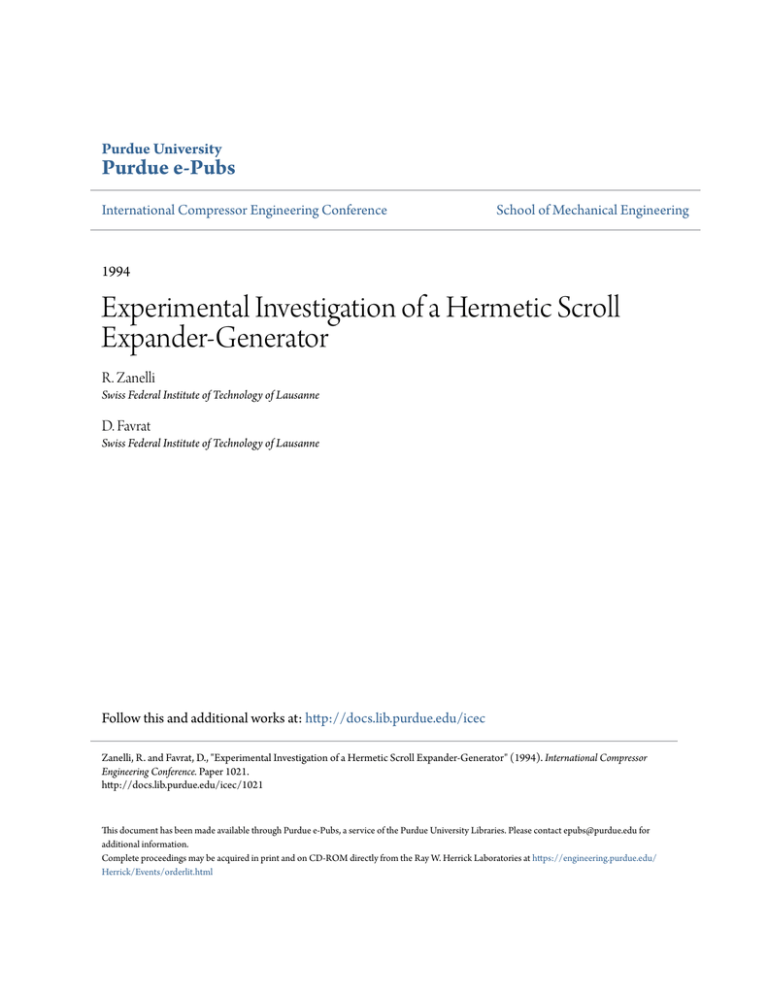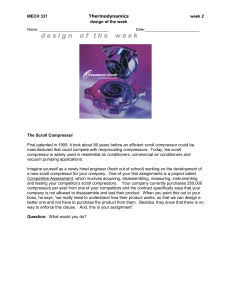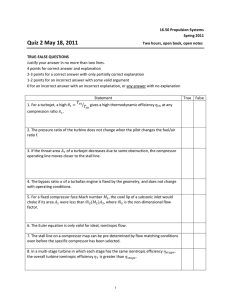Experimental Investigation of a Hermetic Scroll - Purdue e-Pubs
advertisement

Purdue University Purdue e-Pubs International Compressor Engineering Conference School of Mechanical Engineering 1994 Experimental Investigation of a Hermetic Scroll Expander-Generator R. Zanelli Swiss Federal Institute of Technology of Lausanne D. Favrat Swiss Federal Institute of Technology of Lausanne Follow this and additional works at: http://docs.lib.purdue.edu/icec Zanelli, R. and Favrat, D., "Experimental Investigation of a Hermetic Scroll Expander-Generator" (1994). International Compressor Engineering Conference. Paper 1021. http://docs.lib.purdue.edu/icec/1021 This document has been made available through Purdue e-Pubs, a service of the Purdue University Libraries. Please contact epubs@purdue.edu for additional information. Complete proceedings may be acquired in print and on CD-ROM directly from the Ray W. Herrick Laboratories at https://engineering.purdue.edu/ Herrick/Events/orderlit.html EXPERIM ENTAL INVESTIG ATION OF A HERMET IC SCROLL EXPAND ER·GENE RATOR R. Zanelli D. Favrat Research engineer Professor Swiss Federal Institute of Technolo gy of Lausanne Laborato ry of Industria l Energeti cs ABSTRA CT This paper describes a 1 to 3.5 kWe hermetic scroll expander-generator modified from a standard hermetic compressor, an organic Rankine cycle test facility built to test expanders up to 10 kWe and a set of experimental results using HCF 134a in the dry vapor domain. Peak overall isentropic efficiencie s in the range of 63 to 65% for speeds of rotation varying between 2400 and 3600 rpm are reported. Performan ce is fairly constant in the range of pressure ratios considered (2.4<PR<4.0). NOMENC LATURE ' lls v [W] electric power [ -] filling factor [J/kg] isentropic enthalpy drop per unit of refrigerant mass [kg/s] [m 3trev) [m 3/kg] refrigerant mass flow rate suction volume [-1 [Hz] inlet specific volume overall isentropic efficiency shaft speed rotation INTROD UCTION New machinery developments are needed in order to give satisfactory answers to current concerns over environmental issues related to energy conversion and use as well as to the long term objective of preserving the Earth's resources. Small scale organic Rankine cycles (ORC) for electro-th ermo-sola r conversion, waste heat recovery or as topping cycles of boilers or absorption (refrigeration) systems could contribute to this objective but often suffer from a lack of efficient and reliable expanders or turbines. In the small to medium range of electric power and with hermetic units able to comply with present environmental concerns, scroll expanders present definite advantag es over other potential volumetric machines. In addition, the reduced number of parts, the ability to cope with two phase working fluids and the inherent reliability proven in compressor mode are major reasons for its wider use in energy recovery. The fast growing mass production of such units as compressors is likely to also contribute to a lowering of the production costs for expander applications. 459 DER OPERA TION CONVE RSION OF A SCROL L COMPR ESSOR UNIT FOR EXPAN tly possible and, therefore, As is the case for all rotary volumetric principles, backward motion is inheren be envisaged. Our initial approach the conversion of most types of scroll compressors to expander mode can sly tested with HCFC22 in an air to was to modify a hermetic unit from the same family of a compressor previou are: a suction volume of 78.41 cc/rev, water heat pump [1]. The main features of the original compressor unit phased asynchronous 2 pole motor) a built-in volume ratio of 2.44, a nominal electric power of 3.75 kWe (3 unit is discharged cooled with the and a nominal rotation speed of 2880 rpm [2]. In compressor mode, the e oil lubricating system. a fixed higher pressure refrigerant in the shell and has a simple differential pressur with a hydrostatic oil thrust bearing. orbiting radius and, a self-adjusting back pressure mechanism coupled d. The original built-in suction check valve of the compressor unit was remove Refrige rant flow: could be considered for the Although several working fluids, as for example propane or butane, bility and global environmental desired applications, HFC 134a was chosen for ease of use, non flamma fed through the central port without acceptance. As shown in figure 1, high pressure vapor is directly high pressure in the shell. The low transiting through the shell. A side hole in the inlet pipe maintains the or upstrea m of the condenser. pressure refrigerant-oil mixture is then discharged through an oil separat Oil flow: is pumped back to the feeding Mobil polyol-ester EAL Artie 68 oil is used. After being separated, oil bottom of the shell where it is sucked pockets of the hydrostatic axial thrust bearing. The oil excess falls to the the working chambers. The oil flow up by the central hollow shaft in order to lubricate other bearing parts and is controlled by a level sensor probe. No oil is fed to the inlet pipe. Electri cal system : ter to a set of capacitors, The 3 phased asynchronous generator is connected through a digital wattme tion was adjusted for each load case an adjustable voltage transformer and a fixed resistive load. This combina functioning of the unit in generator in order to generate the minimum reactive power needed for the proper mode. ORGAN IC RANKI NE CYCLE TEST FACILI TY ture of 80 oc (hot water) and a The cycle presently operates between a maximum heat source tempera The facility is equipped with a plate minimum heat sink temper ature of 5 oc (industrial cooling water). ne liquid refrigerant feed pump evaporator, a plate superheater and a plate condenser, as well as a membra tor enables an easy adjustment of driven by an inverter. A refrigerant liquid bypass upstream of the evapora s. The latter is particularly useful the expander inlet conditions in the superheated as well as in the wet domain heat supply such as is found, for when assessing control strategies for the ORC system with a varying with the main flow circuit allows the example, in solar systems. A complementary fluid tank branched in parallel available at the evaporator, turbines adjustment of the refrigerant charge when the cycle is at rest. With 60 kW 2500 kPa. with a power of up to1 0 kWe could be tested at a maximum pressure of 460 INSTRUMEN" J:ATION The expander is instrumented with inlet and discharge pressure transducers, inlet and discharge temperature sensors (type K thermocouples) and a high precision digital wattmeter. The shaft rotation speed is recorded through a dynamic pressure sensor located at the pipe inlet. The ORC facility instrumentation includes two coriolis flow meters and basic temperature and pressure sensors which permit the determination of the energy balance for each component and the management of the plant. Each sensor is individually and carefully calibrated. Data acquisition and controls are done with a Hewlett Packard 3852a data acquisition system and with a National Instrument analog output board driven by Lab VIEW software on a Macintosh PC. RESULTS AND DISCUSSION Present results cover primarily superheated conditions, with a fixed inlet temperature of 70°C and a fixed discharge pressure of 450 kPa for four speeds of rotation (40, 50, 60 and 70 Hz). Continuous signal display is used to ensure steady state conditions before recording test data. Processing of the data is based on fluid thermodynamic properties calculated with a Lee-Kesler equations of state software package [3). Definitions used are as follows: Overall isentropic efficiency: '11 = Eelectric s m-.1.h s Filling factor : The results plotted in figures 4 and 5 show the most significant performance values. Power for auxiliaries (oil and refrigerant pumps) is not considered. The overall isentropic efficiency is given as a function of the ratio of the measured pressure ratio to the built-in adapted pressure ratio. The latter is calculated on the basis of an isentropic expansion corresponding to the built-in volume ratio. The overall isentropic efficiency is fairly flat over most of the pressure ratio range considered (pressure ratio varying between 100 and 160% of the built-in pressure ratio) and for speeds of rotation close to the nominal value (40 to 60Hz). Lower and more scattered results observed at 70 Hz can be partly explained by the unsatisfactory lubrication conditions at such high speed. Peak efficiencies approaching 65% have been measured at the nominal speed of 50 Hz (3000 rpm) and a pressure ratio of 3.2. As expected, peak efficiencies occur at increasing pressure ratios as the speed of rotation increases with a resultant relative decrease in mechanical losses. The filling factor exhibits a fairly constant behaviour at a given speed of rotation over the range of pressure ratios tested. The decrease of the filling factor with increasing rotation speeds is consistent with the relative decrease of the internal clearance losses and the increase of the inlet throttling losses. The electric power curves shown in figure 6 exhibit a close to linear behaviour as a function of the pressure ratio for the three best speeds of rotation identified. On the basis of these results and the ones 461 above and provided that the lubrication system is improved, prospects exist for the use with satisfactory performance of such expanders over an even wider range of rotation speed than previously explored. Finally, the oil mass flow is not accurately measured but can be estimated from the volumetric pump rating to be of the order of 8% of the mass flow of refrigerant for all test points. Because of the relative warming effect of the oil in the working chambers, internal isentropic efficiencies ( enthalpy drop over isentropic enthalpy drop) do not fully reflect the effective internal performance of the machine. For the best range of speed, they vary between 75 and 58 % for effective pressure ratios varying from 100% to 160% of the adapted pressure ratio. A detailed simulation model is presently under way which will, among other factors, account for these internal heat transfer effects and allow an accurate determination of the associated polytropic efficiencies. CONCLUS ION The successful conversion of a hermetic scroll compressor into a scroll expander-generator followed by promising performance results opens the way to a new class of modular ORC units in the small power range. HFC 134a proved to be a suitable candidate as a working fluid for such a purpose. Compact plate evaporators and condensers successfully used in the dedicated test rig built for these tests confirmed their suitability for the contemplated applications. Future work includes expansion in the wet region (a condensing expander), detailed simulation modeling, the test of a higher capacity unit with a low shell pressure and the coupling with a higher temperature ORC stage. ACKNOW LEDGMEN TS The authors wish to thank the Swiss Federal Office of Energy for their financial support. REFEREN CES [1] Th. Afjei, P.Suter, D. Favrat, Experimental analysis of an inverter-driven scroll compressor with liquid injection, 1992, Purdue compressor conference [3] Hitachi scroll compressors, Technical catalog No. HR-E443, 1986 B. I. Lee, M.G. Kesler, A generalized thermodynamic correlation based on three-parameter [4] corresponding states, May 1975, AIChe Journal (Vol. 21, No.3), T. Yanagisawa, T. Shimizu, M. Fukuta and T. Handa, Study on fondamentaiPerformance of scroll [2] Expander, 1988,Trans. Jpn. Soc. Mech. Eng. 854-506, 2798 [5) Platell Peter, Displacement expanders for small scale cogeneration, Lie. Thesis, KTH Stockholm, 1993, ISRN KTH/MAK/LA-93/1-SE 462 FIGURES Figure 1: Modified scroll expande r t~ IP,T, ~ !P,T,v Figure 2: Diagram of the ORC system j (J)(Ll r---~-----==-, ~~f~)~ @ ~ @ ..... rpnT o:o o:o · ®)r 0 ..... n:J ..... n:J a. Q) VI ~ j i HP vapor ----- Y<J-: HPhqwd 8~0<-: generator level sensor 1 Iinverter 1-: @ I Icapacitors f-- --I watt mete' I I ~ -I I I transform er - - - resistances :~-·-1· \·~ 0-=_]-£><3-· ®0.0 . L@ Hot water Figure 3: Photogra ph of the ORC test facility 463 Cold water •;• ·a: •• Figure 4: Overall Isentrop ic Efficenc ies • • 65 •• Ill >- 0 60 • c: Q) ·u lE Q) 0 ·a. 0 c 50 .~ • . ;A . • 45 . • • • • • c• 0 Ill 0 Ill _._ -~- • • •o l:l 0 .o -·•••• o. Ill 40Hz 50 Hz 0 60Hz 70Hz • .... ..- ............ ~ ~ m ............. 1.7 1.6 1.5 1.4 1.3 1.2 1.1 1.0 0 Ill • 40 0.9 ~ -• • ....__............... • ttl .... Q) > 0 • -- 0 • c: Q) i·~. Ill 0 55 ~ -~ .Ill Measured pressure ratio/adapted pressure ratio [-] Figure 5: Filling Factor 125 .... 120 ~ £..... Ill Ill Ill .... 115 N 110 ... Cl c: -~ 105 0 0 LL • 100 • • •• •• 95 2.2 - ·. : • • ,. . • 00 • • • • • ,_ • • -· 00( 0 0 0 oo 0 a • • •• • • • • • •• 0 0 0 0 4.0 3.8 3.6 3.4 3.2 3.0 2.8 Measured pressure Ratio [-] 2.6 2.4 0 Ill ·"' m ...... • 0 -- m Figure 6: Electric al power 3500 ~ ... Q) 3:: ................... ...................... ....................... ....................... ................. 3000 2500 -+----+-----!~-·-·-·- ....................................-- :--·--·- - .lo•oo o • • ttl 0 2000 _,_---+-----i-·---+--·--+--:~;a-~'~ • - •· ,. m m o-. j • 1500 t5 Q) 1000 0 a.. ·;:: w -~-C? . 2.4 • • .. .. 0 .0 : • - ,.._ • 0 ... m m o• Ill 500 2.2 ~ 2.6 2.8 3.0 3.2 3.4 Measured pressure Ratio [-] 464 3.6 3.8 4.0



